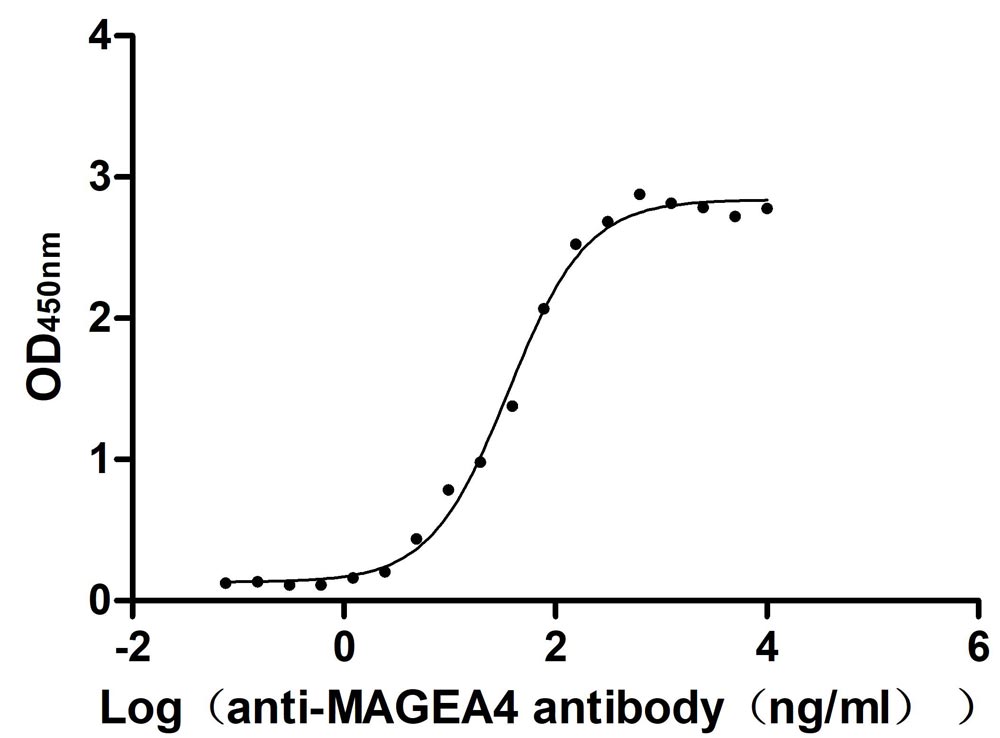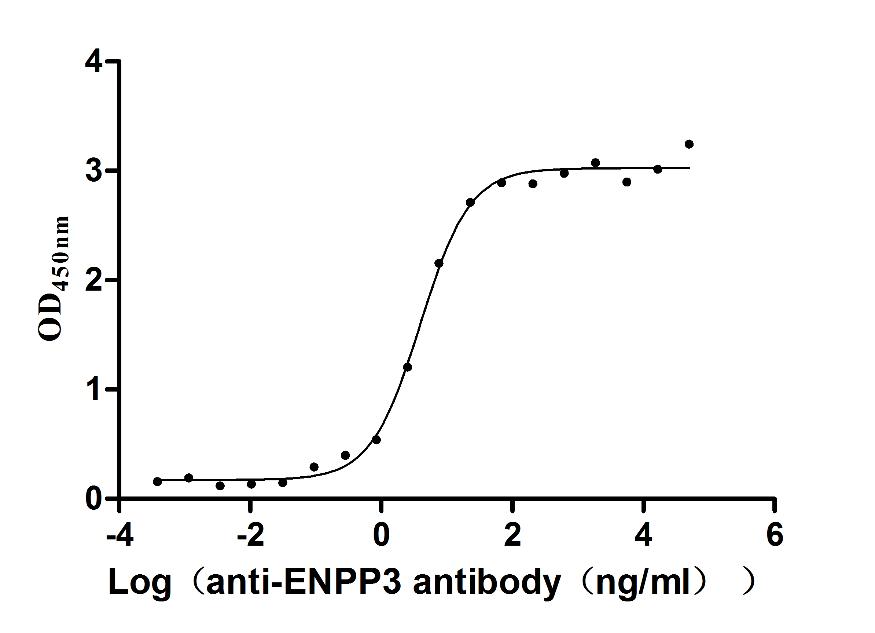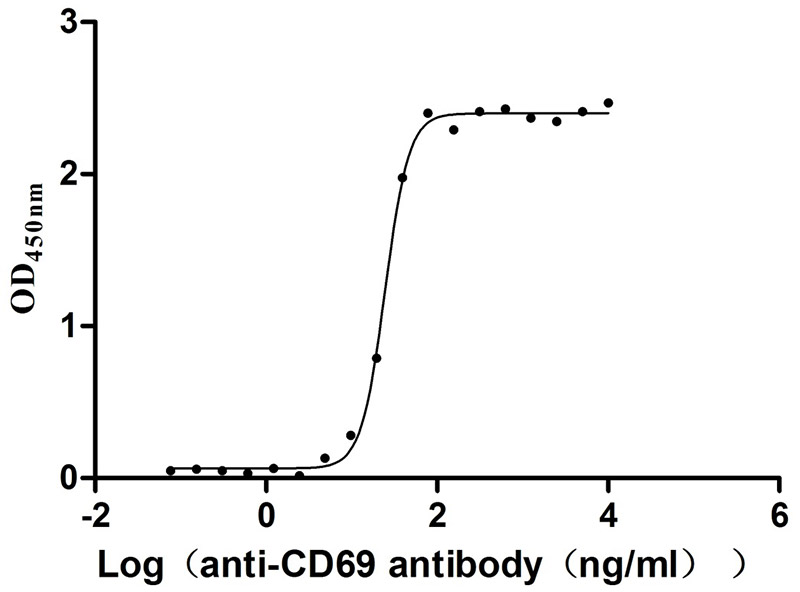Recombinant Mouse Gap junction delta-2 protein (Gjd2)
-
货号:CSB-CF009461MO
-
规格:
-
来源:in vitro E.coli expression system
-
其他:
产品详情
-
基因名:
-
Uniprot No.:
-
别名:Gjd2; Gja9; Gap junction delta-2 protein; Connexin-36; Cx36; Gap junction alpha-9 protein
-
种属:Mus musculus (Mouse)
-
蛋白长度:Full length protein
-
表达区域:1-321
-
氨基酸序列MGEWTILERLLEAAVQQHSTMIGRILLTVVVIFRILIVAIVGETVYDDEQTMFVCNTLQP GCNQACYDRAFPISHIRYWVFQIIMVCTPSLCFITYSVHQSAKQRERRYSTVFLALDRDP AESIGGPGGTGGGGSGGSKREDKKLQNAIVNGVLQNTETTSKETEPDCLEVKELTPHPSG LRTAARSKLRRQEGISRFYIIQVVFRNALEIGFLVGQYFLYGFSVPGLYECNRYPCIKEV ECYVSRPTEKTVFLVFMFAVSGICVVLNLAELNHLGWRKIKLAVRGAQAKRKSVYEIRNK DLPRVSVPNFGRTQSSDSAYV
Note: The complete sequence including tag sequence, target protein sequence and linker sequence could be provided upon request. -
蛋白标签:N-terminal 10xHis-tagged
-
产品提供形式:Liquid or Lyophilized powder
Note: We will preferentially ship the format that we have in stock, however, if you have any special requirement for the format, please remark your requirement when placing the order, we will prepare according to your demand. -
缓冲液:Lyophilized from Tris/PBS-based buffer, 6% Trehalose, pH 8.0
-
储存条件:Store at -20°C/-80°C upon receipt, aliquoting is necessary for mutiple use. Avoid repeated freeze-thaw cycles.
-
保质期:The shelf life is related to many factors, storage state, buffer ingredients, storage temperature and the stability of the protein itself.
Generally, the shelf life of liquid form is 6 months at -20°C/-80°C. The shelf life of lyophilized form is 12 months at -20°C/-80°C. -
货期:Basically, we can dispatch the products out in 1-3 working days after receiving your orders. Delivery time may differ from different purchasing way or location, please kindly consult your local distributors for specific delivery time.Note: All of our proteins are default shipped with normal blue ice packs, if you request to ship with dry ice, please communicate with us in advance and extra fees will be charged.
-
注意事项:Repeated freezing and thawing is not recommended. Store working aliquots at 4°C for up to one week.
-
Datasheet & COA:Please contact us to get it.
相关产品
靶点详情
-
功能:One gap junction consists of a cluster of closely packed pairs of transmembrane channels, the connexons, through which materials of low MW diffuse from one cell to a neighboring cell.
-
基因功能参考文献:
- data suggest a possible contribution of Cx36 to ALS pathogenesis amyotrophic lateral sclerosis PMID: 29246791
- Results indicate that even though Cx36 may be required for electrical coupling of suprachiasmatic nucleus cells, it does not affect coupling of molecular clock gene rhythms. Thus, electrical coupling of neurons and coupling of circadian clock gene oscillations can be regulated independently in the suprachiasmatic nucleus. PMID: 28576728
- In mice, strain differences were found, such that punctate labelling for Cx36 was differentially distributed in the molecular layer of C57BL/6 vs. CD1 mice. Cx36-puncta were localized to processes of stellate cells and other cerebellar interneurons. The vast majority of Cx36-puncta co-localized with Cx45-puncta, which in turn was associated with the scaffolding protein zonula occludens-1. PMID: 28561933
- Cx36 deletion therefore disrupts normal regulation of sympathetic outflow with effects on cardiovascular parameters. PMID: 28533325
- Deletion of connexin 36 increased the frequency and shifted the amplitude distributions of miniature inhibitory post synaptic potentials. PMID: 26864476
- retinal aberrant activity was reduced in the rd10/Cx36KO mice compared to rd10 controls, a direct evidence for involvement of Cx36-containing gap junctions in generating aberrant activity in RD. PMID: 26005040
- The results suggest that electrical synapses formed by Cx36-containing gap junctions occur in most of the widely distributed centers of the auditory system. PMID: 26188286
- The resilts of this study showed that the phosphorylation state of Cx36 as a key biochemical step at the crossroad of light-dark and circadian regulatory pathways that control photoreceptor coupling. PMID: 26241696
- The magnitudes of the 2f1-f2 distortion products were not different between Cx36 knockout and wild-type mice, suggesting similar cochlear function in the two groups PMID: 25891643
- Mg(2+)-dependent synaptic plasticity of Cx36-containing electrical synapses could underlie neuronal circuit reconfiguration via changes in brain energy metabolism that affects neuronal levels of intracellular ATP and [Mg(2+)]i. PMID: 25135336
- Gene expression data indicate that EPCs, or their soluble products, modulate the expression of the beta-cell surface molecule connexin 36 and affect glucose-stimulated insulin release in vitro. PMID: 24069942
- Some neurons exhibit at least two discriminatory mechanisms for assembling Cx36 into gap junctions. PMID: 24463820
- The Cx36 was expressed in the mouse carotid body and in the intestine at ileum and colon level. PMID: 22897942
- The results indicate the presence of Cx36-containing gap junctions in the sexually dimorphic dorsomedial nucleus and dorsolateral nucleus of both male and female rodents PMID: 24304165
- The genetic deletion of the GJ subunit Cx36 increased cell survivability by approximately 50% under excitotoxic condition. PMID: 25100592
- Data (including data from studies in knockout mice) suggest that Cx36/Gjd2 gap junction channels are necessary for full up-regulation of insulin secretion by islet cells; mice with defective Cx36/Gjd2 expression exhibit glucose intolerance. PMID: 24735890
- knockout of Cx36 in mice with ATP-insensitive KATP channels restores glucose homeostasis and normal insulin secretion. PMID: 24458355
- Because Cx36 expression and function is reduced in type 2 diabetes, the resulting defect in intraislet blood cell flow regulation may also play a significant role in diabetic pathology. PMID: 24326425
- This study demonistrated that regulation of interneuron excitability by gap junction which containing Gjd2 coupling with principal cells in mice. PMID: 24185427
- disruption of connexin36-mediated rod-cone coupling does not stop, delay or spatially restrict secondary cone degeneration and suggest that the gap junction-mediated bystander effect does not contribute to the progression of RP. PMID: 23468924
- Deletion of connexin 36 is neuroprotective, resulting in a better functional outcome and decreased infarct size after cerebral ischemia. PMID: 22960118
- The intercellular synchronization of Ca2+ oscillations evaluates Cx36-dependent coupling. PMID: 22848521
- These results indicate that gap junctions formed by Cx36 in spinal cord are required for maintenance of presynaptic inhibition, including the regulation of transmission from Ia muscle spindle afferents. PMID: 22615430
- the differences in Purkinje cell complex spike activity between wild type and cx36 knockouts likely reflect the loss of electrical coupling of inferior olive cells PMID: 17853112
- Results provide a context in which to examine functional relationships between these proteins at Cx36-containing electrical synapses in brain. PMID: 22722764
- The data identify Cx36 as a novel early marker of beta cells and as a target of Beta2/NeuroD1, which is essential for beta-cell development and differentiation. PMID: 22729650
- It was concluded that connexin-36 gap junctions regulate the in vivo dynamics of insulin secretion, which is important for glucose homeostasis. Coordinated pulsatility of individual islets enhanced first-phase elevation and second-phase pulses of insulin. PMID: 22511206
- Data suggest that gap junction coupling of beta-cells mediated by Cx36 is impaired in prediabetic mice (induced along with obesity by high-fat diet); prediabetic mice exhibit decrease in islet Cx36 and glucose-stimulated insulin secretion. PMID: 22569071
- Connexin 36 is expressed in beta and connexins 26 and 32 in acinar cells at the end of the secondary transition of mouse pancreatic development and increase during fetal and perinatal life. PMID: 22505190
- during development, acute activation of group II mGluRs causes up-regulation of Cx36 via post-transcriptional mechanisms PMID: 22342304
- Electrical transmission is supported by connexin36 (Cx36)-containing gap junctions at somato-somatic contacts of MesV neurons. PMID: 22457486
- both AF6 and MUPP1 are associated with Cx36-containing interneuronal gap junctions that form electrical synapses in adult rodent brain PMID: 22211808
- Cx36 deficiency in the mouse leads to reduced CaMKII levels in the striatum and behavioral changes in open-field activity, anxiety-related behavior in the light-dark box and one-trial object-place recognition. PMID: 21889545
- Cx36 decreases apoptosis & protects mouse beta cells against both cytotoxic drugs & cytokines in the islet environment at the onset of type 1 diabetes. Proinflammatory cytokines decreased its expression. PMID: 22056383
- We characterized connexin36 (Cx36)-expressing neurons of the adult rat somatosensory cortex PMID: 21467210
- Data suggest that learning and memory deficiencies in Cx36 knockout mice are due to deficiencies in LTP mechanisms. PMID: 21798314
- elimination of electrical synapses formed by connexin36 altered inhibitory efficacy and caused frequency facilitation of inhibition consistent with a decreased GABA release in the inhibitory network PMID: 21804029
- findings demonstrate the behavioral relevance of Cx36 gap junction-mediated electrical coupling between GABA neurons in mature animal PMID: 21638336
- The cx36 strongly modulate the firing pattern of individual RGCs, ensuring strongly correlated firing between nearby RGCs and normal patterning of retinogeniculate projections. PMID: 21734291
- in the 4-aminopyridine model of epilepsy in vitro, connexin36 is not critical for the generation of epileptiform discharges in GABAergic networks PMID: 21300748
- Results identify a motif within connexin 36 that may interact with other trafficking or scaffold proteins and thereby be responsible for its incorporation into electrical synapses. PMID: 20510366
- Cx36 is the predominant subunit of gap junctions in the proximal mouse retina, expressed by most ganglion cell subtypes, and thereby likely plays a major role in the concerted activity generated by electrical synapses PMID: 20058323
- Cx36 plays a role in the generation of certain forms of network synchronisation in the hippocampus PMID: 12042356
- Results indicate that connexins 26 and 36 are not present in mouse horizontal cells and therefore cannot contribute to feedback inhibition or horizontal cell coupling. PMID: 12064619
- spatial and temporal expression of connexin36 protein in neurons of the central nervous system PMID: 12107497
- Expression of mRNA encoding cx36 is observed in the olfactory epithelium mainly in ventral and lateral regions of the turbinates. PMID: 12687708
- connexin 36 expression is regulated by the transcriptional repressor NRSF/REST PMID: 14565956
- There is a molecular link between Cx36 and the stimulus-secretion pathway leading to insulin secretion. PMID: 14681053
- Connexin36 is localized to beta cells of pancreatic islets. PMID: 14980497
- Adequate but not excessive levels of Cx36 allowed for recover of normal insulin secretion in response to various secretagogues. PMID: 15023528
收起更多
-
亚细胞定位:Cell membrane; Multi-pass membrane protein. Cell junction, gap junction.
-
蛋白家族:Connexin family, Delta-type subfamily
-
组织特异性:Highly expressed in neurons.
-
数据库链接:
KEGG: mmu:14617
STRING: 10090.ENSMUSP00000087742
UniGene: Mm.389394




-AC1.jpg)















